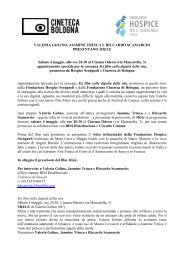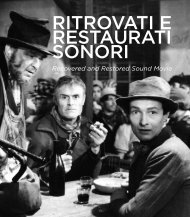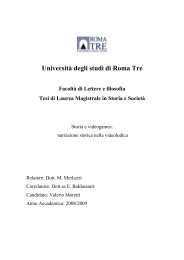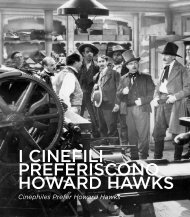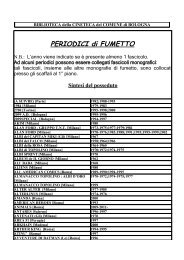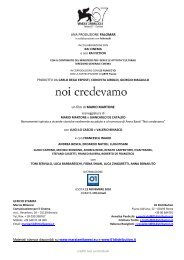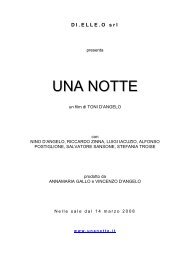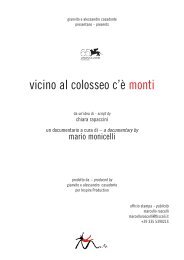Catalogo 1999 - Cineteca di Bologna
Catalogo 1999 - Cineteca di Bologna
Catalogo 1999 - Cineteca di Bologna
You also want an ePaper? Increase the reach of your titles
YUMPU automatically turns print PDFs into web optimized ePapers that Google loves.
the “drifter” fragment consents to the mo<strong>di</strong>fication of the negative attention that the actress has<br />
suffered over the years.<br />
(Vittorio Martinelli)<br />
JÖN AZ ÖCSÉM (My brother is coming, Ungheria, 1919). R.: Mihály Kertész . S.: dal poema <strong>di</strong><br />
Antal Farkas, Sc.: Iván Slik Kovács ósi. Scgf.: Mihàly Kertész. In.: Oszkár Beregi (fratello siberiano),<br />
Ferkó Szécsi (bambino), József Kürthy (l’uomo), Ilonka Kovács (Lucy Doraine, la donna). 35mm. L.:<br />
235m. D.: 8’ a 16 f/s<br />
Da: Magyar Filmintezet<br />
Si tratta dell’unico film ungherese <strong>di</strong> Mihály Kertész ancora esistente. Venne<br />
realizzato nella primavera del 1919, dopo lo scoppio della rivoluzione, a illustrazione<br />
<strong>di</strong> un poema <strong>di</strong> propaganda scritto da Antal Farkas e apparso il 26 marzo sul giornale<br />
socialista “Népszava”. Il testo del poema da cui è tratto il film appare nelle<br />
<strong>di</strong>dascalie. Il film inizia con un ritratto <strong>di</strong> vita quoti<strong>di</strong>ana <strong>di</strong> una famiglia composta da<br />
tre persone, in un ambiente tipicamente operaio: il padre legge, la madre cuce, il figlio<br />
li osserva. Improvvisamente la porta si apre per una folata <strong>di</strong> vento. La famiglia si<br />
mette in ascolto, aspettando l’arrivo <strong>di</strong> qualcuno. Ora ve<strong>di</strong>amo il fratello dell’uomo<br />
che combatte al fronte, dove viene ferito e imprigionato. Sui muri del carcere una<br />
scritta: “Proletari <strong>di</strong> tutto il mondo, unitevi!”. Il fratello, evaso dal carcere, agita una<br />
ban<strong>di</strong>era e arringa la folla. La porta si apre <strong>di</strong> nuovo. Il fratello tanto atteso fa irruzione,<br />
mentre una folla <strong>di</strong> rivoluzionari marcia nelle strade. Ora la famiglia, in un ambiente borghese, guarda<br />
dalla finestra il corteo che sfila nella strada.<br />
This is Mihály Kertész’s single surviving Hungarian film. It was made in Spring 1919, after the<br />
outbreak of the revolution, in order to illustrate a propaganda poem by Antal Farkas, published on<br />
March 26 in the socialist paper “Népszava”. The text of the poem appears from time to time in the<br />
intertitles. The film starts with the portrayal of a family of three people, seen at home and in a typical<br />
workers’ milieu: the father is rea<strong>di</strong>ng, the mother is sewing, and the child is watching them. Suddenly<br />
the door opens, but it was just the wind. They listen outwards, waiting for someone. Now we can see<br />
the brother of the man fighting on the front, where he is wounded, then sent to prison. On the prison<br />
wall there is an inscription: “Proletarians of the world, unite!”. The brother, escaped from the prison,<br />
is now waving a flag and talking to the mob. The door opens again, and the much awaited brother<br />
steps in, while a large revolutionary crowd marches in the streets. The family is now seen in a<br />
bourgeois milieu, looking at the march in the street from the window.<br />
CHUJI TABI NIKKI (Il <strong>di</strong>ario <strong>di</strong> viaggio <strong>di</strong> Kunisada Chuji - Giappone, 1927). R., S., Sc: Ito<br />
Daisuke. F.: Watarai Rokuzo, Karasawa Hiromitsu.<br />
Frammento della seconda parte Shinshu kessho hen (Bloody Laughter in Shinshu): In.: Okochi Denjiro<br />
(Kunisada Chuji), Nakamura Hideo (il ragazzo Kantaro), Nakamura Kichiji (ricco mercante), Sakamoto<br />
Seinosuke (Bunzo).<br />
Frammento della terza parte Goyo hen (In the Name of the Law): Okochi Denjiro (Kunisada Chuji),<br />
Isokawa Motoharu (ricco produttore <strong>di</strong> Saké), Sawa Ranko (Okume, sua figlia), Murakami Eiji<br />
(Ginjiro, suo figlio), Akitsuki Nobuko (Shinobu, la geisha), Onoe Kajo (Otozo, un Yakuza), Nakamura<br />
Koka (Gantetsu), Ichikawa Momonosuke (Jukichi), Fushimi Naoe (Oshina, la concubina <strong>di</strong> Chuji).



